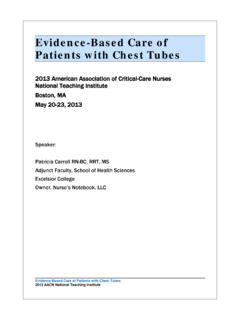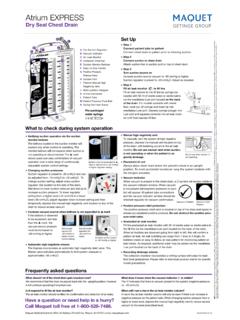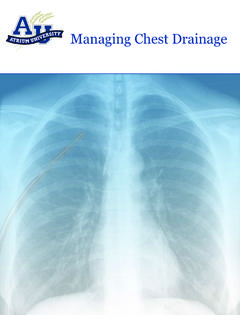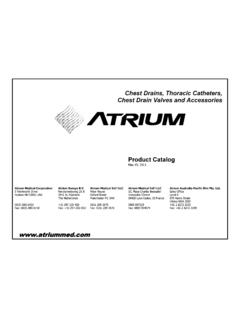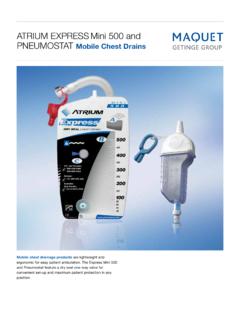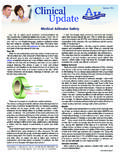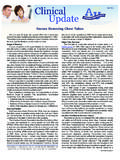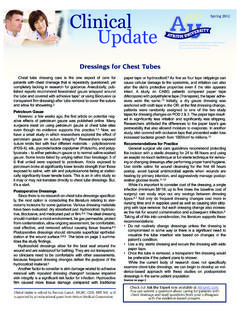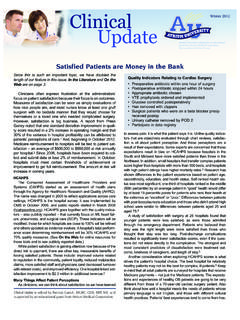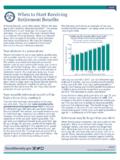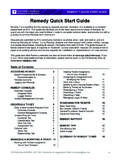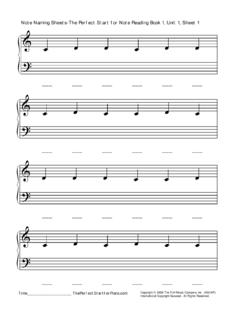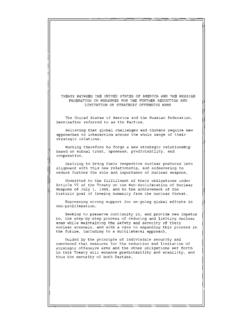Transcription of A Personal Guide to - Atrium Med
1 A Personal Guide to Managing Chest Drainage Dry Suction Water Seal Chest Drainage Table of contents Your Personal Guide to Managing Dry Suction Chest Drainage is a quick and easy reference to help extend your understanding of dry suction chest tube drainage and to help answer questions which may come up from time to time. It is provided as an educational service of Maquet. This booklet has been prepared as an educational aid only and is not intended to replace any medical or nursing practices or hospital policies. Due to numerous model types available, it is important to carefully read and follow each corresponding product insert prior to use.
2 Introduction Making it simple to understand.. 4. How dry suction water seal CDUs function The Basic operating system.. 5. Fluid collection.. 6. Water seal .. 6. Dry suction control.. 7. The Maquet system All the water you less! .. 8. Features, benefits, function.. 10. Product Feature Summary.. 12. System set up Open package.. 14. Requirements for set up.. 14. Four step set up.. 14. What to check during system operation Verifying suction operation.. 18. Increase vacuum source when bellows Is not expanded to s mark .. 18. 2. Changing suction pressures.. 19. Recording drainage volume.
3 19. Placement of unit.. 19. Verifying water seal operation .. 20. Observing changes in patient pressure .. 20. High negativity float valve .. 20. Observing water seal for patient air leaks .. 21. Graduated air leak monitor .. 21. Sampling patient drainage.. 21. Manual high negativity vent.. 22. Positive pressure protection .. 22. Swing out floor stand.. 22. Multi-position hanger holders .. 22. In-line patient tube connector .. 23. Patient tube clamp.. 23. Gravity drainage.. 23. System disconnection .. 24. Anatomy and physiology review Anatomy of the chest.. 24. Why the lungs are expanded.
4 25. The mechanics of breathing.. 26. Why water seal CDUs are used Clinical needs for chest tube drainage.. 27. What to check for during CDU use .. 30. Chest tube placement Chest tube insertion.. 31. Chest tube nursing responsibilities .. 32. Troubleshooting Guide Questions and answers.. 33. 3. Introduction Making it simple to understand The purpose of any chest drainage device is to help re-establish normal vacuum pressures by removing air and fluid in a closed, one-way fashion. The need for chest drainage is also required following open heart surgery and chest trauma to evacuate any pooling blood which, if left in the mediastinal cavity, can cause cardiac distress or tamponade.
5 Hence, chest drainage is indeed a life-saving procedure and one of the most important services a physician and nurse clinician can render. While the practical application of water seal chest drainage techniques are relatively simple, sometimes the chest drain and its accompanying terminology may appear complex. However, dry suction water seal chest drainage systems are actually quite simple to manage and easy to understand. It is our hope that a review of this educational aid booklet will help enhance your working knowledge of chest drainage and further familiarize you with Maquet's easy-to-use dry suction water seal operating system.
6 Customer service If a question or need arises for customer service, product information, or to request inservice educational material, we invite you to call anytime. In the 1-800-528-7486. Outside the 603-880-1433. FAX 603-880-6718. For additional information about Atrium products refer to 4. How dry suction water seal CDUs function The basic operating system Today's water seal drainage systems are comprised of a one-piece, 3-chamber set up, which separates the functions of fluid collection, water seal (which serves as a simple one-way valve), and suction control. An easy way to describe the one-way action of a water seal is to refer to a cup of water and a straw.
7 If one were to blow air into a submerged straw, air would bubble out through the water. Now if you wanted to draw the air back through the straw, you would only draw water. When chest drainage came into light many years ago, the one-way action of a water seal (water bottle and straw concept) provided a simple but ideal means for evacuating air and not allowing it to return to the patient. G. F. A B. D. E. A Dry suction control B Water seal chamber C Air leak monitor D Collection chamber C E Suction monitor bellows F Tube to suction G Tube from patient 5. Advances in engineering have enabled dry suction technology to be incorporated into familiar water seal operating systems.
8 Consequently, today's dry suction water seal operating systems not only provide a simple and convenient method to maintain a required amount of vacuum in a patient's chest, but now provide fast set up times, quiet operation and the ability to impose higher levels of controlled suction with the simple turn of the dial. Additionally, these new compact, lightweight chest drains better address the hospital's critical need for reduced disposal costs. Fluid collection In a dry suction water seal operating system, fluids drain from the patient directly into a large collection chamber via a 6-foot patient tube (3/8" ).
9 As drainage fluids collect in this chamber, the nurse will record the amount of fluid that collects on a specified schedule. Therefore, an easy-to-read, well graduated collection chamber is an important feature for any chest drainage system. Water Seal The water seal chamber, which is connected in series to the collection chamber, allows air to pass down through a straw or narrow channel and bubble out through the bottom of the water seal. Since air must not return to the patient, a water seal is a simple, cost effective means for protecting the patient, in addition to being a very useful assessment tool.
10 The water seal column is graduated and acts as a water manometer for measuring intrathoracic pressure. As changes in intrathoracic pressure occur, fluctuation in the water level can be observed in the graduated column. Such fluctuations provide the clinician an indication of how 6. the patient is progressing. With the addition of an advanced float valve at the top of the water seal, a patient can also be protected from the dangers of accumulating high vacuum pressures or high negativity, which can be induced from chest tube stripping or milking. Today's more sophisticated systems provide such patient protection both manually and automatically.
